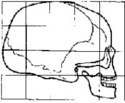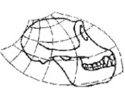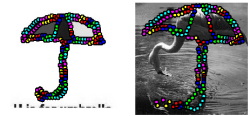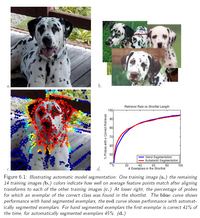Shape and Object Recognition
We address comparing related, but not identical shapes in images. As
concrete examples, consider the images
above. How similar are the two skulls? Are the two elephants shown
from the same species? How similar are the helicopters in the two
scenes? At the heart of all these questions is the notion of an
alignment between the shapes to be matched. The transformation
necessary for alignment and the remaining differences after alignment
are then used to make a comparison.
The search for an alignment is quite difficult, in general this is a
search for the maximum of a non-convex function in an infinite
dimensional space of non-rigid deformations. It can be approximated
by an easier discrete matching problem between key points on a model
and a novel object. This is a departure from traditional approaches
to deformable template matching that concentrate on analyzing
differential models.
We attack the problem of matching shapes in two steps: computing
measures of local shape similarity (geometric
blur) and finding a correspondence that has low overall distortion
and similar local shapes.
One result is a mathematical and ecological motivation for a medium
scale descriptor of shape, geometric blur.
Geometric blur is an average over transformations of a sparse signal
or feature channel, and can be computed using a spatially varying
convolution. The resulting shape descriptors are useful for
evaluating local shape similarity. Experiments demonstrate their
efficacy for image classification and shape matching.
Finding alignments between shapes is formulated as an optimization
problem over discrete matchings between feature points in images.
Similarity between putative correspondences is measured using
geometric blur, and the deformation in the configuration of points is
measured by summing over deformations in pairwise relationships. The
matching problem is then an integer quadratic programming problem and
can be approximated with a simple technique. Experimental results
indicate that this generic model of local shape and deformation is
applicable across a wide variety of object categories, providing very
good performance for object recognition and localization on a
difficult object recognition benchmark.
In addition to object recognition the shape matching framework allows
us to build models of object variation. One example application is
to take a number of images of a category of object and automatically
segment the objects from their background by identifying what parts
of the images can be aligned.
Both geometric blur and the integer quadratic programming framework
are useful in other contexts. Other work using geometric blur is
mentioned here, and the IQP framework shows up
here.
Papers
Shape Matching and Object Recognition using Low Distortion Correspondence
[pdf]
[ps]
[ppt]
Alexander C. Berg,
Tamara L. Berg,
Jitendra Malik
IEEE Computer Vision and Pattern Recognition (CVPR) 2005
| |
(Presents a framework for using geometric blur and integer quadratic programming for object recognition.) |
Shape Matching and Object Recognition
[pdf]
[ps]
Alexander C. Berg
Ph.D. Thesis, Computer Science Division, U.C. Berkeley, December 2005
| |
(Presents more detail on the motivation for geometric blur, etc.) |
|







